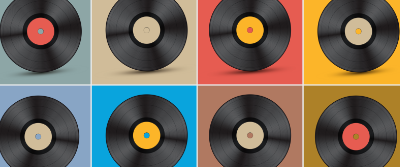Vinyl Revival: The Science of Spinning and the Allure of Record Sound

By Gina Wynn
For the first time since 1987, vinyl records outsold CDs, according to a recent Recording Industry Association of America report. Some say this resurging popularity of vinyl is being driven by nostalgia and others credit the comeback to its unique sound.
Older music enthusiasts may be more influenced by nostalgia. People who grew up in the 1970s may remember joyfully playing tunes on portable turntables, spending hours scrutinizing album cover art, and memorizing every lyric printed on record sleeves to help them sing along to their favorite songs.
Groovy Sound
As for the unforgettable sound of vinyl, some prefer it over the studio-sampled tones of digital recordings. Often described as “warm,” the rhythmic crackling sounds you hear when a record plays actually come from deficiencies in turntables, according to Stanley Lipshitz of the Audio Research Group at the University of Waterloo in Canada as reported in the Popular Science article “Are Records Really Better?” by Corey Binns.
Lipshitz said that sound waves coming out of the speakers, along with the needle’s passage over the hills and valleys of the grooves carved into records, cause them to vibrate as they revolve. Some consider these added vibrations musical imperfections, but many find them appealing.
Manufacturing Hits
Although vibration causes mixed feelings among listeners, it’s an unintended byproduct of record manufacturing, an intricate process that requires attention to detail. Before manufacturing can begin, however, the songs or “tracks” designated for the record must go through a process called mastering. This is when specially trained sound engineers check the sequencing and quality of each track and optimize them for vinyl.
The mastered files are then turned into grooves on a lacquer plate through a technique called lathe cutting. Electroplating follows, meaning the grooves are filled in, raised, and turned into stampers, much like an ink stamper.
Next, polyvinyl chloride (PVC) pellets are heated and compressed hydraulically between two stampers to add the essential grooves to both sides of the record. The grooves replicate the shape of the sound waves produced by the musicians. The newly grooved records are then cooled, trimmed, shaped, and checked for quality. Once approved, they undergo a final curing process to prevent warping.
Musical Merry-Go-Round
To hear the music on a vinyl record, you place it on a turntable, which has a spinning base and a needle called a stylus at the end of a thin arm. The stylus vibrates and travels over the grooves of the record as it spins, and the vibrations are turned into an electrical signal by a cartridge at the end of the arm. This signal is then sent to the record player’s amplifier, allowing us to hear the music.
Arguments can be made about whether your favorite songs sound better this way or whether CDs, cassette tapes, or digital formats provide better audio experiences. Most people can agree that the sound of each format is different, but not necessarily better. Fortunately, we can choose whichever is the most pleasurable and convenient when we need a musical boost.

